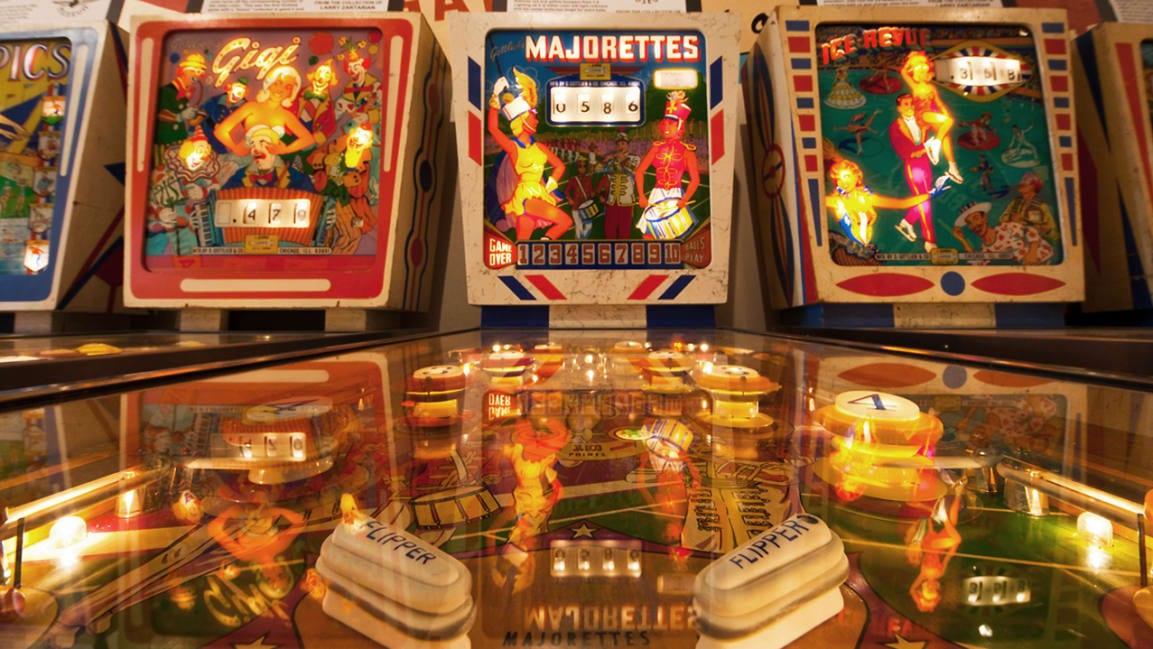The cofounder of Digg has a plan to modernize pinball machines with online leaderboards and achievements. But so does the world’s largest pinball company.

About five years ago, Jay Adelson was restoring an old pinball machine with his teenage son when he had a revelation.

Adelson, who cofounded the social news website Digg in 2004, had been talking to a couple of friends, Brian O’Neill and Ron Richards, about how to connect pinball machines to the internet. They knew that bringing these mechanical monstrosities online would allow for neat features like community scoreboards and personal records, but they hadn’t quite figured out how to proceed. Everything clicked, Adelson says, when he and his son revived The Machine: Bride of Pinbot as a father-son bonding experience.

Ben Adelson with the guts of a pinball machine in the process of being restored.
[Photo: courtesy of Jay Adelson]
“You can change the game”
Pinball machines have gone through plenty of changes over the years, but the guts of most machines from the late 1970s onward have some common elements, including a processor, memory, and a display. To bring those machines online, Scorbit uses a custom piece of hardware called the Scorbitron to intercept game scores, error codes, and other bits of data, usually on their way to the display. To make the connection, Scorbit has devised a series of connectors, or “probes,” that can plug into hundreds of different machines. “There’s no data that a machine generates that I can’t collect,” Adelson says. The Scorbitron then sends the data out to Scorbit’s online servers, which in turn will power an app that players can use to track their high scores and compete with friends. Leaderboards will no longer be bound to a single machine, and players will be able to unlock achievements for different games. Machines that support Scorbit may be able to accept mobile payments—instead of quarters or tokens—as well. Scorbit will also offer an API for developers who want to build their own applications around the company’s data. One might imagine, for instance, a tournament board that updates scores in real time, or a local arcade that offers its own achievements system. “You can change the game, or add value to a game that might have been a little bit boring before,” Adelson says. “Now, all of a sudden there’s this new layer of challenges and rewards.” Scorbit is pitching itself as a service for commercial pinball machine operators as well, allowing them to analyze which prices and game settings generate the most revenue, and notifying them when a machine breaks down or goes offline. Because Scorbit’s business model mainly involves selling hardware at a profit, the hope is that operators’ investments in Scorbitrons will pay for themselves. “Imagine you’re a guy with 100 machines in New York City, and your job is to drive around and repair them and collect the money out, ” Adelson says. “And you don’t show up at a venue again for two weeks or three weeks, and you show up and it’s off … Now you have weeks of earnings that you’ve lost because the machine’s been off. So operators have a very different view of what’s important in a connected pinball machine.”
The Scorbitron adds internet smarts to existing pinball machines.
[Photo: courtesy of Scorbit]
“Nobody wants to do something hard”
Straightforward as all this may sound, Adelson says figuring out how to connect four decades’ worth of pinball designs—from old solid state machines to modern ones with 4K LCD displays—was a major challenge that’s taken about five years to solve. “I looked at this, and I said, ‘Why hasn’t anyone done this?’” Adelson says. “And while restoring it, and soldering it, and looking at it, I just realized, ‘Oh, I see what’s going on: It’s hard.’ And nobody wants to do something hard.” Adelson started batting around the idea with a couple of friends in 2014, which is around the same time that his son, Ben, had started taking a “maker” class in high school. Adapting to high school had been tough for Ben, who has dyslexia and some learning differences, but he engaged with the maker class on a level that Adelson says he’d never seen before. Adelson’s wife, Brenda, had the idea to channel that newfound passion into a pinball restoration project. “Some dads throw a ball around with their kid. I’m more of a nerd, so for me, this is a pretty epic moment, and it absolutely changed our lives, both of ours,” Adelson says. As the restoration went on, Adelson became more confident about what he would need to build Scorbit, and he started looking for outside help. He reached out to a pinball enthusiast named Edward Cheung, who had written extensively online about his efforts to replace the circuitry of old Williams pinball machines with modern field-programmable gate arrays. Cheung convinced Adelson that Scorbit would need its own custom hardware, and he now owns a stake in the startup. Adelson only realized later on that Cheung is better known for his day job at NASA, where he helped engineer the Hubble Space Telescope and was knighted by Dutch royalty for his work. “I had no idea,” Adelson says. “[I thought] he was just a pinball guy in pinball forums.” Today, Scorbit employs about a dozen people, though not everyone is working on the project full-time like Adelson. Scorbit also enlisted Olivier Galliez, a French developer known in pinball circles for writing firmware modification software. The resulting company, Adelson says, is one that grew organically through the pinball community, and the pace isn’t anything like the startup world, where he’s operated as a CEO, founder, and advisor since cofounding Digg and streaming network Revision 3. Although Scorbit has investors, funding is “on a monumentally lower scale” than traditional startups, Adelson says, and he’s not particularly interested in changing that. “We just don’t feel like we’re in a rush,” he says. “It’s just a different world. And what is the size of the business? It could be a venture business, but I don’t want venture capital for this. I want to do this myself.”
Pinball fans trying out a Scorbit-enabled machine.
[Photo: courtesy of Scorbit]
Pinball’s sneaky revival
Even if the connected pinball machine business won’t make venture capitalists giddy, Scorbit is arriving at just the right time for pinball. Paul Mandeltort, the COO of pinball parts supplier Marco Specialties, estimates that as many as 15,000 new pinball machines will ship this year, adding to the 1 million to 2 million machines that he believes are in existence worldwide. (Adelson thinks the number of machines in operation is closer to 500,000.) As the largest online supplier of pinball components, Marco’s business has also grown by 20% to 30% every year for the last five years. “The pinball industry as a whole is on a huge growth spurt right now,” Mandeltort says. This isn’t peak pinball, he adds, but the current trend seems more sustainable than the industry’s last big boom in the 1990s. Back then, pinball vendors were pumping out as many as 100,000 machines every year, mostly to arcades, amusement centers, and other public environments. But as arcades fizzled out, and operators got tired of maintaining expensive pinball machines, the glut led to a crash. The biggest names in pinball from the 1980s and early 1990s, such as Williams and Bally, either collapsed or moved on to other businesses. Mandeltort says much of the current growth is coming from pinball enthusiasts, who grew up playing in arcades or bowling alleys and now have the disposable income to buy their own machines. For these players, pinball represents a kind of escape from modern technology. “People are just saturated with the internet,” Mandeltort says. “They don’t want to look at screens anymore for entertainment, but they want to be entertained, so they want something physical. Pinball ticks all the boxes there.” That enthusiasm has also been feeding on itself through pinball tournaments, where anyone can go and play both new and old machines. The International Flipper Pinball Association says that between 2010 and 2018, the number of pinball tournaments per year has increased almost tenfold, and attendance at these events has jumped from 16,625 to 133,751 over the same period. At the same time, pinball is going through a more public revival in “barcades,” family amusement centers, and new-school bowling chains such as Lucky Strike. George Gomez, the chief creative officer for Stern Pinball, says that roughly half the company’s business comes from these venues, where the player demographics skew younger. “There’s a real visceral experience related to playing pinball that, while you can emulate it on digital devices, you’ll never truly replicate it,” Gomez says. “And so, we’ve focused on evolving and developing a new audience, while at the same time retaining our traditional audience.”
Stern’s pinball lineup includes Star Wars, Star Trek, Guardians of the Galaxy, Batman, The Munsters, and other franchises.
[Photo: courtesy of Stern]
The pinball platform war
Despite all the talk of pinball disconnecting us from our screens, Stern has been interested in internet connectivity as well. But as a self-funded company that almost went out of business during the 2008 economic recession, Stern had to be judicious about its investments.
“There isn’t any magical place in the sky where money falls out to do R&D,” Gomez says. “Growing the business of the company is the thing that sustains new technology initiatives, new product design initiatives, new evolutions for the product.”
Now, Stern is ready to tackle internet connectivity in earnest. The company designed its most recent pinball system, called Spike, to support online features through an add-on module, and plans to roll out some of those capabilities later this year. While Gomez is cagey about the details, he says it’s a “significant” offering, and the broad strokes sound similar to what Scorbit is doing, with social features for players and remote monitoring for operators.
“I can’t speak to what [Scorbit is] doing, or how they’re doing it,” he says. “But it doesn’t make any sense that you would take a new Stern pinball machine and apply their stuff to it, because our infrastructure’s going to be fairly robust and very functional.”
All of which means that in a year or so, pinball players may be looking at two competing ecosystems, each with their own high score lists, achievements, and promotions. Connecting pinball machines to the internet, in other words, might also introduce some internet-era headaches.
Adelson doesn’t seem too concerned, noting that Scorbit can still work on new machines from other companies such as Jersey Jack and Spooky Pinball, along with the hundreds of thousands of older machines that are still in operation. He’s also hoping Stern and Scorbit can find a way to work together.
“When you look at the total inventory of equipment out there, they’re 10% of it,” Adelson says. “We have to focus on the bigger picture, but I think the right answer is a partnership.”
Either way, Adelson seems to be enjoying the break from the Silicon Valley bubble he’s operated in for the past couple of decades. Instead of advising and funding startups, he’s been geeking out in pinball forums, talking to pinball industry veterans, and bringing Scorbit to pinball tournaments to gather feedback. His son, Ben, is often along for the ride as Scorbit’s “intern,” and last month at the Golden State Pinball Festival, they even brought a couple of restored machines–including The Machine: Bride of Pinbot–with them for demos.
“We’re responding to something that’s happening culturally, and it’s pretty exciting to me because I do think it’s a good thing,” Adelson says. “I think it’s a positive thing, and my son certainly thinks so, because it changed his life.”
